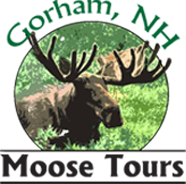Moose Facts
- An adult moose can average 1,000 -1,500 pounds, stand 6 to 7 feet at their shoulder and can be 8 – 9 feet in length. It is the largest land mammal in New Hampshire.
- Moose are near-sighted, but have a keen sense of smell and hearing.
- Their front legs are longer than their hind legs, allowing them to maneuver over large obstacles in the woods.
- Male moose or “Bulls” have a dark brown / black muzzle, while the female moose or “Cows” have are light brown.
- Only Bulls grow antlers. Bulls grow a new set every spring and shed them in the winter. The new set of antlers will be larger than the year prior. Adult antlers may weigh as much as 40lbs.
- The flap of skin / long hair that hangs from the throat is called the “Bell” and is more pronounced in adult bulls.
- The life expectancy for moose is 10-12 years, although some may live for up to 20 years.
- The breeding season, also called “the rut,” is in the fall, from mid-September to mid-October. Moose also become more aggressive during this time.
- Calves are born in mid-May or early June and weigh just 20-30 pounds; by fall their weight will have increased to 300-400 pounds. Female moose are pregnant for 8 months.
- Bear and Coyotes are predators on moose calves until the calves are old enough to outmaneuver them.
- Moose are susceptible to a tiny parasite known as the brain worm, which the may die from. The parasite passes from the White-tailed deer feces to a snail, which the moose eat while feeding.
- Moose also susceptible from severe infestations of winter ticks. A single moose can carry 10,000 to 120,000 ticks. Moose also die as a result of collisions with automobiles.


